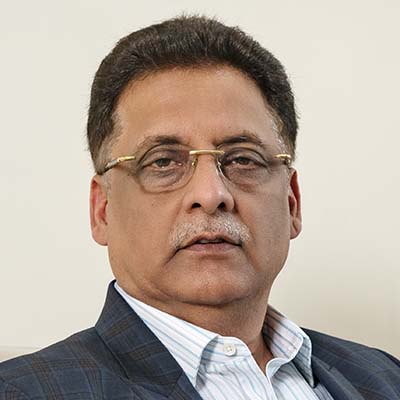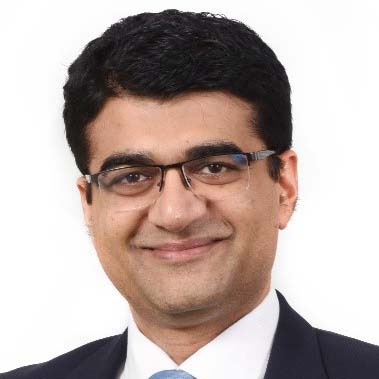

- CM Grover
- CEO and MD, IBSFIntech

- Siddharth Rungta
- Head of Global Payments Solutions, HSBC India

- Tom Alford
- Deputy Editor, Treasury Management International
India’s Foundation for Success
India is the birthplace of some of the world’s largest and most innovative tech vendors. It also plays host to a plethora of smaller fintechs challenging for leadership. We explore the relationship the country has with the technology sector, revealing the key moments of the last decade that have assured its rise to prominence among corporate finance and banking communities.
India is rightly hailed as home to many of the world’s foremost tech centres. Bangalore is known as the ‘Silicon Valley of India’, while cities such as Pune, Hyderabad, Delhi National Capital Region, and Chennai vie with each other to be the top development centre.
Fintechs are flourishing as a result. India has more than 9,000 entities in this space, ranking it third globally. With a 14% share of startup funding in the country, ‘finnovation’ is big business. And while treasury tech is but a small component of this vast industry, the numbers alone should raise expectations among treasury professionals that the right solutions are close at hand.
Citizens for progress
Many countries could be considered technologically advanced without having anywhere near the industry standing enjoyed by India. For Siddharth Rungta, Head of Global Payments Solutions, HSBC India, the key to this success story lies in just how far into Indian society digitisation has reached, and the fact that this progress is very much by design.
“Digital transformation in the last decade is evident across all sectors, and it’s reflected in India’s growing pursuit of technology as the driver of economic growth, enhanced governance, and an improver of the quality of life of its citizens,” he comments.
Digitisation has reached the majority of the country’s 1.45 billion population in some shape or form. This is aided by an age demographic that shows around 65% of India’s population is under the age of 35.
“India’s impetus for digitisation across all sectors is transforming the technology landscape, creating a fertile ground for innovation,” notes CM Grover, CEO and MD, IBSFINtech, an India-based global TMS provider. Complemented by a “highly skilled, professional and talented workforce” and a “robust education system”, a new generation of entrepreneurs “are creating a vast emerging startup community”.
Perhaps the most important trigger for the rise of ‘digital India’ though has been the country’s steadfast governmental focus on creating an all-inclusive digital public infrastructure. By immersing every individual in digital practice at the most fundamental level – that of official identity – it becomes almost second nature. And from here, a market is continuously developing to meet the increasingly broad expectations of the digitally native population, with electronic consumer payments and other financial activities following naturally.
A subsequent competitive driver for businesses to meet customers’ digital demands, has emerged, while business professionals will also innately import their own experiences and expectations of slick consumer technology into their own commercial systems.
A very public infrastructure
Notwithstanding mass public acceptance, there is one further vital element to the rise of digital enterprise in India; it has perhaps the world’s most ambitious and successful roll-out of a digital public infrastructure initiative. Derived from a public and private partnership approach, this decade-long ongoing programme has three pillars, explains Rungta.
The first is the Aadhaar digital identification card. Aadhaar is a Hindi word meaning ‘foundation’. Launched in January 2009, it gives every citizen of India a unique 12-digit identity number based on their biometric and demographic data. Although a voluntary programme, today more than 1.3 billion Aadhaar cards have been generated.
The second pillar, notes Rungta, is the “democratisation of payments”. This has been made possible through the roll-out of the National Payments Corporation of India’s (NPCI) unified payments infrastructure (UPI). “It provides a completely open-ended [in that it is not a closed-loop wallet structure], real-time, 24/7/365 retail payment system,” he explains. “With its open architecture, UPI enables a significant amount of innovation in both the consumer and corporate spaces.”
Pillar number three, says Rungta, is consent-based information sharing. This is similar to open banking in the UK and Europe, for example, but has far greater reach because it also enables individuals to digitise and save a wide range of personal information in a national digital repository.
Stored information could include their Aadhaar identity card, their permanent account number (PAN) income tax identifier, passport, and bank account and other financial data. Individuals can then grant consent for selected data to be shared within the ecosystem.
With all three initiatives co-ordinated at government level, it has provided the trust required for each to achieve mass adoption. The foundational pillars, and thus the rise of digitisation in India, are supported by “other enablers”, notes Rungta.
The idea of financial inclusion – ensuring every individual can at least access a bank account and become part of the formal financial ecosystem – is driven by the Indian government. More than 500 million new bank accounts have been opened since the plan’s launch a decade ago.
Another enabler is India’s elevated levels of access to internet and mobile technology. In early 2024, 78% of the population was active mobile users, and internet penetration stood at 52.4%. Some 46.5% was using smartphones in 2022, but with evidence of strong year-on-year growth into 2024.
Intense competition in the mobile market between just three private operators, and India’s natural economies of scale, ensures even high-speed internet services are “among one of the cheapest in the world”, Rungta notes. With the majority of internet access via mobile, India has “probably leapfrogged the whole laptop generation, moving straight onto smartphones with highly affordable internet data services,” he says.
Alongside the introduction of digital identities and data sharing – which enabled e-KYC – it was India’s mobile-readiness that enabled hundreds of millions of new bank accounts to be opened. And that inclusion, says Rungta, has created a massive spike in usage of digital payments such as UPI and other digital financial services provision.
Given that the core platforms used across these initiatives are all open architecture and API-based, it’s clear that the intention has always been interoperability. This facilitates access by the wider vendor and fintech community, as well as for banks. It also drives competition, creativity and innovation, which in turn has helped to ramp up the scale of adoption in the shortest time frame.
So, unlike in some Asian markets, Rungta says the Indian consumer payments space today has minimal closed-loop or wallet-based systems, nor any need for them. “UPI ensures a bank account holder is able to easily and securely transfer money from any bank account to another, 24/7/365.”
Rapid business proposition
While Aadhaar, UPI and the notion of information exchange are founded on the needs of the individual, B2C players such as retailers, consumer goods and insurance firms, have also felt the reach of this broad technology initiative. This is especially so in consumer payments processing, with cash and cheques increasingly sidelined.
In the B2B payments space, the Reserve Bank of India (RBI) the country’s central bank and regulator, has driven two important changes in terms of availability and uptake, notes Rungta. “India is probably the only country today where even the RTGS [real-time gross settlement] system, which is a high-value payment rail, operates 24/7/365.” RTGS transfers, which operate account to account only, are unlimited in value and are immediate. RTGS, operated by RBI, was initially for the settlement of inter-bank transactions only but was soon expanded to cover settlement of customer transactions.
Another payment rail, National Electronic Funds Transfer (NEFT), owned and operated by RBI, is for lower-value batch based electronic transfers. Although not real time, NEFT was also made 24/7/365 by the regulator, with the objective of driving further digitisation and user convenience.
But the digitalisation of India’s payments space started before the arrival of UPI and the consumer boom, with RTGS rolled out in 2004, and NEFT in 2005. Their early arrival, coupled with 24/7/365 availability at the start of this decade, has ensured a high level of B2B uptake, notes Rungta. “Most corporates use digital rails for over 90% of their payments. Now business and consumer payments are feeding off each other in terms of driving further adoption, particularly for receivables.”
Progress is not just in payments, of course. The goods and service tax (GST) replaced India’s previous complex and fractured VAT system in 2017. With the necessary technological infrastructure in place, it now caters to centralised taxpayer registration, return filing, and tax payments. The system showcases a major digital shift in India’s tax structure, which the GST Council (of ministers and state representatives) says has created “a more unified, efficient, and transparent indirect tax regime”.
The advent of GST, followed by e-invoicing, has created a national repository of B2B transaction-level data. And, notes Rungta, this has encouraged a number of fintechs to offer added-value solutions to businesses, “either on their own or in partnership with banks”. In enabling new services for uploading, downloading, processing and analysing this vast nationwide data base, he says it enhances credit access across the entire business ecosystem.
“Smaller businesses often faced a challenge in accessing credit because they did not have authenticated digital data in support of their business flows, making it difficult for banks to cater to credit needs at the bottom of the pyramid,” he explains. “Now they do, it becomes easier, and perhaps cheaper, for them to access credit. And larger corporates are also able to use the system to better understand, manage, and support their supply chain counterparties, for instance through the targeted offering of supply chain financing via banks and/or fintechs.”
With the innovative technological pathway now fully open in India, whether the government is collecting sales tax, custom duties or corporate income tax, or individuals are storing and sharing their own identity data, and making payments to each other or businesses, “it’s all digital!”, exclaims Rungta.
xTech emerges
With the foundational pillars for this structure laid to provide an open and interoperable architecture, India continues to see a vibrant tech community tapping into new opportunities. Indeed, there are a host of niche players in relatively new industries such as regtech, edtech, insurtech and, of course, fintech.
The Indian government’s 2024 fintech industry market valuation is estimated to be around $110bn, notes IBSFINtech’s Grover. By 2029, he says it is projected to reach close to $500bn. In an economy that Statista projects will reach $6tr. by 2029, the value of this sector is clearly high and rising.
The reason for such expected growth is simple: corporate finance is one of few areas in the global IT ecosystem that remains stubbornly manual. When the main competitor for any fintech is Excel, it’s obvious this is a largely untapped market. As the challenges within the corporate finance industry become more apparent, the need for digitisation grows, says Grover. “Entrepreneurs are already keenly addressing these issues with innovative solutions. And with strong government support for various initiatives, the fintech space is becoming a magnet for innovators.”
Unbundling the marketplace
The Indian tech community is acutely aware that interoperability is key to scaling up any digital industry. However, government assistance is never far away. The Open Network for Digital Commerce (ONDC) represents its move to drive e-commerce to new levels. Steered by a private non-profit company but established by the Indian Government’s Department for Promotion of Industry and Internal Trade, ONDC aims to give any seller an easily discoverable online presence. “It’s a set of specifications designed to unbundle the idea of the marketplace,” explains Rungta.
The traditional online marketplace requires an aggregator to bring sellers and buyers together on a single platform. ONDC removes the aggregation element, instead delivering a set of APIs and an open-source internet protocol to enable separate components to connect into a loose network.
The protocol enables a full range of trade participants (individuals and business buyers, sellers, logistics firms, financers et al) to use their own apps to discover each other, and securely trade their goods and services.
“The model has no marketplace or central authority – an aggregator – so it’s akin to a many-to-many network, based on technology protocols, with the fintech community innovating alongside it,” comments HSBC India’s Rungta. Established fintechs that are already extending UPI payment functionality with millions of individual users and merchants on their platforms, as well as a whole new set of fintechs, are creating new buyer/seller apps to connect to ONDC. And NPCI is now working on a centralised settlement system enabling payments within the ONDC ecosystem, he adds. “Once that goes live, ONDC will scale up quickly.”
By combining Aadhaar, UPI, India’s mobile-readiness, and high internet penetration enabled by affordability, rapid digital growth in the country seems inevitable. A 2023 report by ONDC and McKinsey, Democratising Digital Commerce in India, claimed that with an open network system of this nature, “India could see digital consumption surge fivefold to reach $340bn by 2030, with 500 million digitally transacting consumers”.
Treasury included
Corporate treasurers should not, however, feel left out. While solutions for cash flow forecasting using AI are already on the radar for many global players, Rungta notes “a local crop of fintechs are customising their offerings to meet some of India’s nuanced corporate and even SME forecasting needs”.
Of course, ‘treasury’ is a broad term. Whether it’s cash management, payments, bank account management, or risk and exposure management, it all ultimately comes under the umbrella of treasury management, notes Grover. With few core platform providers today covering the entire sweep of treasury functionality, he says the clear need for peripheral technologies is engaging the interest of fintechs.
“This growing demand is creating a dynamic environment,” he states. “With a new generation of tech-savvy CFOs and treasury leaders that are willing to tackle treasury’s needs with technology, the more demand grows, the more interest it generates for other players to join in.”
One of the key triggers for treasury transformation was the pandemic. “During Covid, when many systems were still manual, there was limited visibility and control over cash and liquidity,” comments Grover. “With the markets so volatile, taking positions on past performance had proven to be a huge risk, and numerous firms suffered during that period. Post-Covid, we’re seeing many more mandates from boardrooms looking to automate treasury operations – it’s a view that has percolated down to SMEs too”, he states.
India is the largest SME market in the world, with around 75 million registered firms contributing more than $1tr. to the country’s economy, yet digitalisation has reached only 30% of these businesses. This represents another huge untapped opportunity.
Of course, the main regulatory authority, the RBI, is also in the mix here, having created a subsidiary, the Innovation Hub, with its own fintech-development function offering a sandbox environment in which developers and corporates are able to safely try new ideas. “There are multiple incubator, or accelerator, programmes in India,” says Rungta. “We’re seeing some of the larger corporates working with, and in some case sponsoring, these programmes.”
What’s more, adds Grover, fintech/bank partnerships continue to flourish and strengthen the ecosystem. “These collaborations are delivering innovative solutions to corporate treasuries and finance functions, especially around payments, reconciliations, counterparty risk analysis, and funding.
Great expectations
The pace, scale, and inclusiveness of India’s relatively short digitalisation journey since 2014 has been phenomenal. From fintechs, to open interoperable networks, its innovations resonate worldwide. But Rungta believes the future holds more exciting possibilities as India continues leveraging its strengths to shape the digital era.
Grover, confident that India’s technologists are set fair to meet the needs of all sectors, concludes: “There are immense opportunities. In a world where change is the only constant, India’s fintech community is forging a path to a more inclusive and resilient future. Through innovation, it is reshaping the financial landscape with unprecedented speed, and expanding the horizons of what’s achievable.”
For corporate treasuries the world over, it is a foundation for continued success.



